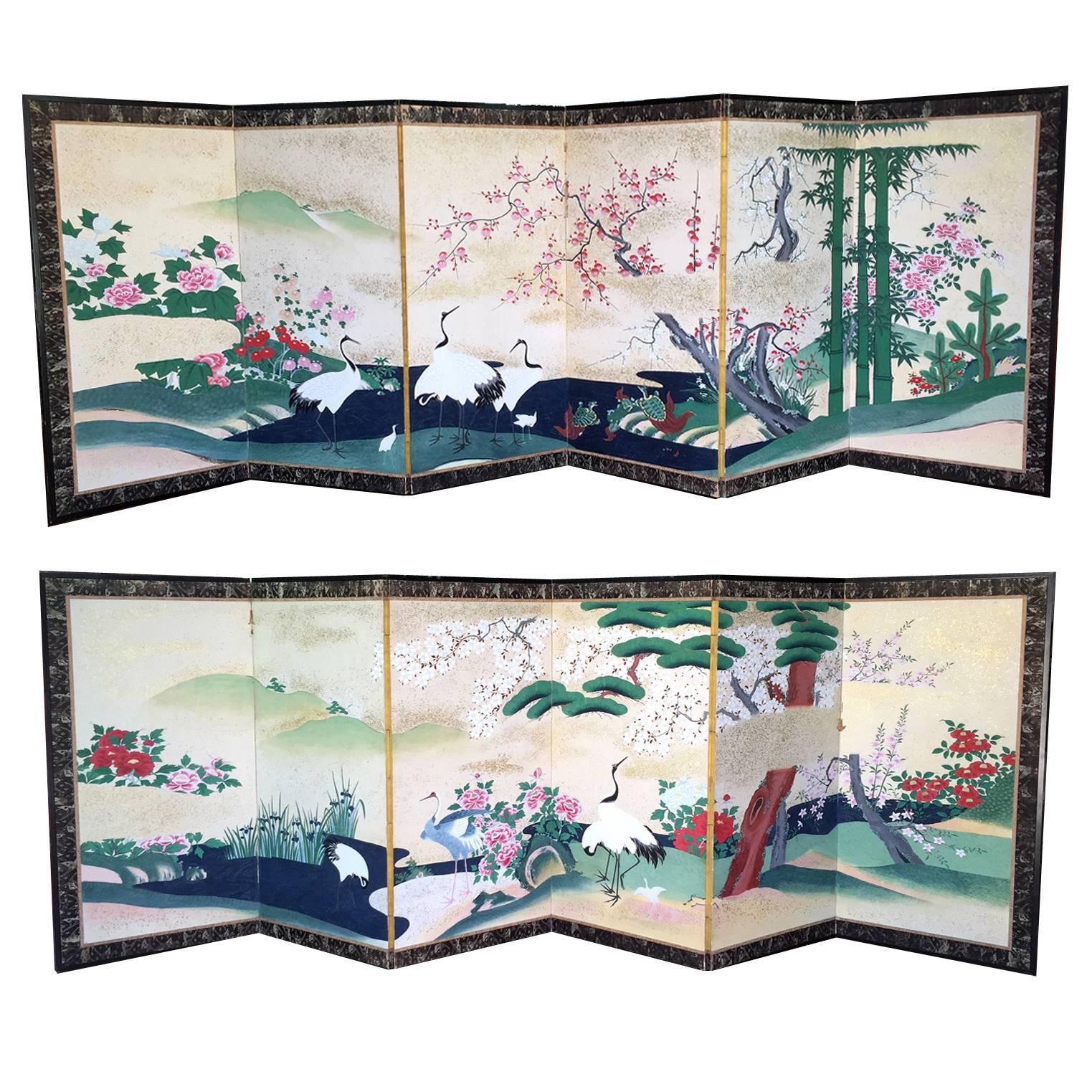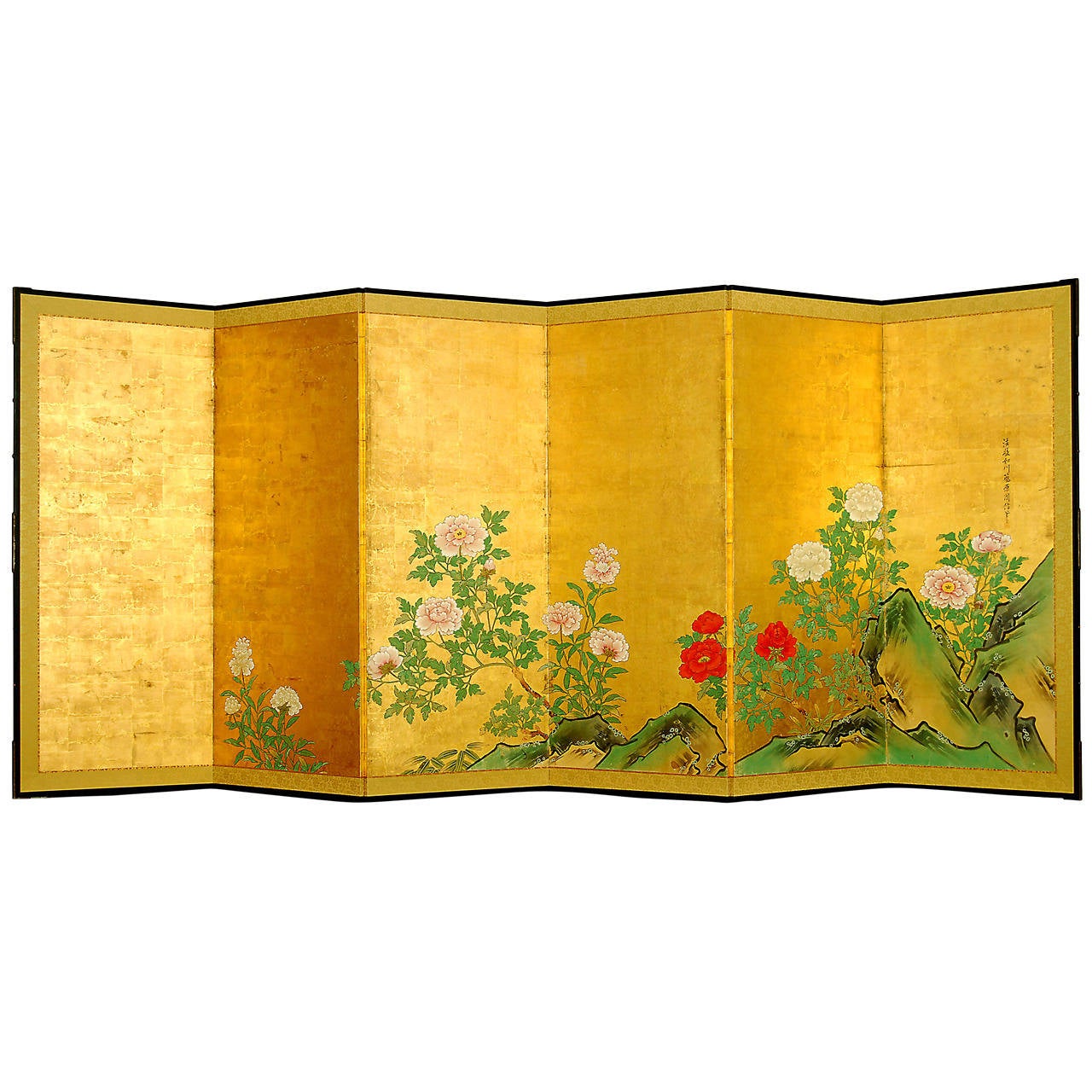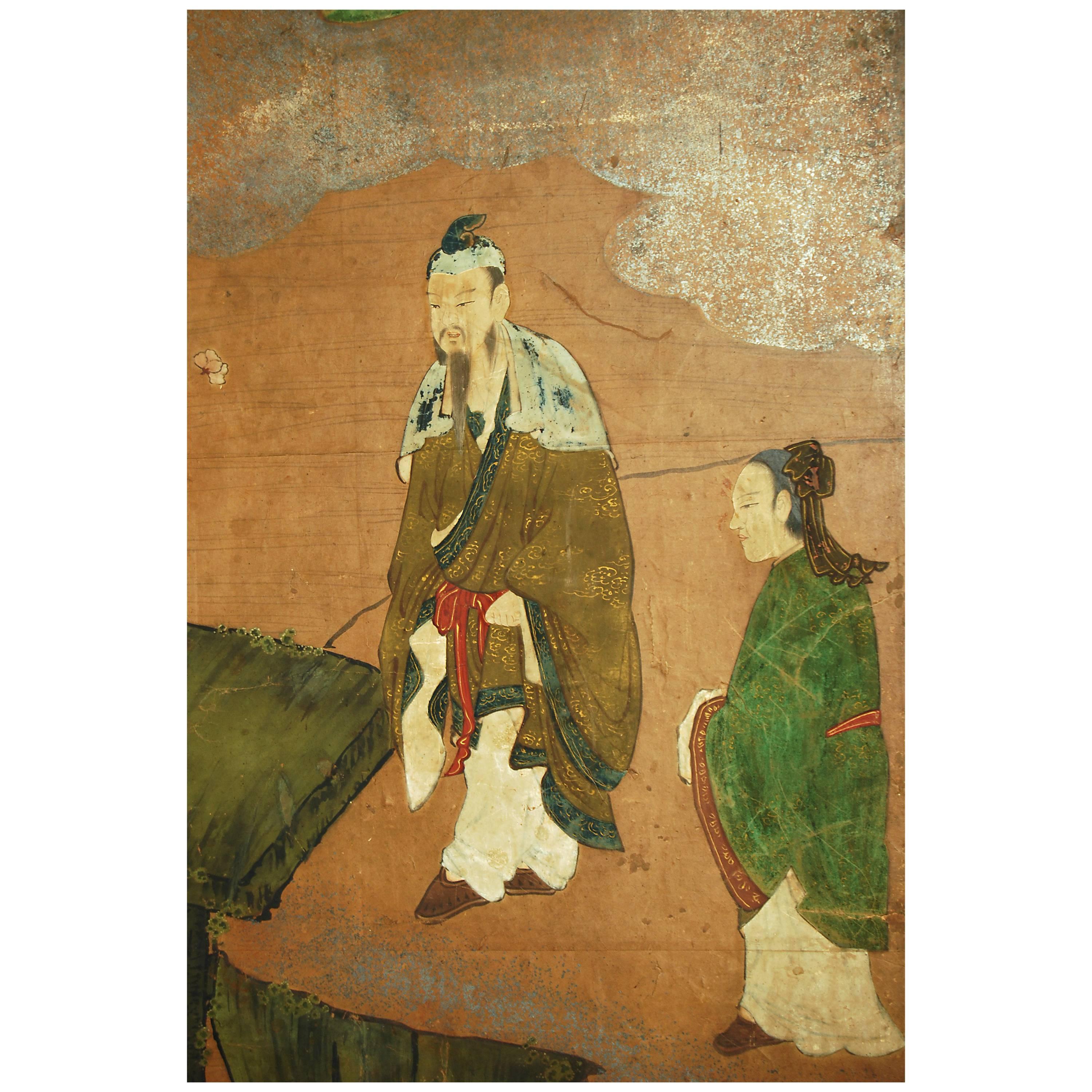Items Similar to Rare Antique Japanese Folding Screen by Kano Tanshin
Want more images or videos?
Request additional images or videos from the seller
1 of 11
Rare Antique Japanese Folding Screen by Kano Tanshin
About the Item
An exquisite Japanese folding screen painted and signed by Kano Tanshin (Morimasa) (1658-1719), circa early Edo Period. An important member of the Kano painter family, the son of Kano Tanyu by his second wife, Kano Tanshin led the Kajibashi branch of the Kano school after 1674.
The screen consists of six fully mounted panels depicts a lively family garden scene with men and children at a leisure play. Mountain, rivers and trees serve as the stage with the gold dust-splashed background. This work is extraordinary both its meticulous artistry and superb condition. It was originally purchased in the early 1970s from the Yatsuhashi Inc, a pioneer Japanese antique and art gallery founded by influential art dealer Harumichi Yatsuhashi (1886-1982) in 1945 in the Beacon Hill, Boston. The work comes with an authentication and appraisal letter written and signed by Harumichi Yatuhashi dated to 1976.
One of the most famous schools of Japanese painting, the Kano¯ school of was the dominant style of painting from the late 15th century until the Meiji period when it further branched into sub-schools. Kano school was rooted in the Chinese literati style painting that focuses on brush strokes but took a firm Japanese identity.
- Creator:Kano Tanshin (Artist)
- Dimensions:Height: 38.25 in (97.16 cm)Width: 112 in (284.48 cm)Depth: 1 in (2.54 cm)
- Style:Japonisme (Of the Period)
- Materials and Techniques:
- Place of Origin:
- Period:
- Date of Manufacture:17th Century-Early 18th Century
- Condition:Wear consistent with age and use. Very fine antique condition with a couple of minor abrasion and pin holes on the pigment. Rubbings on the backing gold patterned paper. Likely remounted some time in the early 20th century.
- Seller Location:Atlanta, GA
- Reference Number:1stDibs: LU94504562953
About the Seller
5.0
Platinum Seller
These expertly vetted sellers are 1stDibs' most experienced sellers and are rated highest by our customers.
Established in 2006
1stDibs seller since 2010
479 sales on 1stDibs
Typical response time: <1 hour
- ShippingRetrieving quote...Ships From: Atlanta, GA
- Return PolicyA return for this item may be initiated within 2 days of delivery.
More From This SellerView All
- Pair of Rare Antique Japanese Folding Screens with ProvenanceLocated in Atlanta, GAAn amazing pair of matching antique Japanese folding screen predating 1812-1813, most likely from Kano School. Six panels each depict C...Category
Antique 1810s Japanese Japonisme Paintings and Screens
MaterialsBrass
- Pair of Japanese Ink Hanging Scrolls Kano TanyuBy Kano Tan'yu 1Located in Atlanta, GAA fine matching pair of hanging scrolls ink on paper mounted in green brocade borders circa Edo period (17-18th century). The Kano school painting depicts wild geese in the reeds by the margin of water, a popular subject borrowed from the Chinese tradition. Both painting were signed as Tanyu with a red seal of Morinobu, his birth name. The storage box is also present and was inscribed with the title Painting of Geese and Reeds and Kano Tanyu...Category
Antique Late 17th Century Japanese Japonisme Paintings and Screens
MaterialsWood, Paper
- Rare Japanese Floor Screen of Perched Eagles Soga Shohaku Edo periodLocated in Atlanta, GAA rare six-panel Japanese folding floor screen (Byōbu) by Soga Shōhaku (1730-1781) from Edo period. The screen depicts six perched hawk-eagles in various poses positioned in a litera...Category
Antique 18th Century Japanese Edo Paintings and Screens
MaterialsBrocade, Wood, Paper
- Two Antique Japanese Hanging Scroll PaintingsLocated in Atlanta, GATwo Japanese scroll painting depicts scenes from the Tale of Genji (Genji-E), from Edo period. These painting were purchased from Odewara Shoten in the...Category
Antique Early 19th Century Japanese Japonisme Paintings and Screens
MaterialsBrocade, Paper
- Korean Folding Chaekgeori Painted Scholar Floor ScreenLocated in Atlanta, GAA six-panel painted folding floor screen from Korea circa early 20th century. This type of screen is called Chaekgeori (books and things) which is quite unique to Korea. It became popular at the end of 18th century favored and encouraged by King Jeongjo (1752-1800) as a political tool to promote social conservatism such as the traditional Confucianism value, especially considered important in a time when waves of new ideology influx came to Korea. Initially commissioned for the royal court, they became increasingly popular with the scholars of noble and affluent household and used it widely in their halls and studies. Early screens were painted with trompe-l’oeil bookcases displaying books and arrays of collectibles. Later, the bookcases were eliminated to focus on the assemblage of neatly stacked books and objects of scholarly pursue. On this screen, the six panels were neatly presented and framed in woven brocade borders. Among the stacked volumes, one can find many fine porcelain vases with flowers, potted orchids, pen holders with brush pens and scroll paintings, incense burner, ink stone, teapot, fan with ink painting, vessels of fruits, exotic plants such as lotus, plumeria and even a pair of glasses. It feels like a pleasant visual measure hunting for the viewers. Several words in Chinese found their way into the picture as well, including filial (xiao), longevity (shou) and luck (fu). The painting was done in a meticulous way with no details overlooked and also with a rather western still-life dimensional perspective. In a rather unusual maximal but also minimalistic way, the screen exudes a folky charm but appears modern at the same time. Each panel is 17.5"w by 70.2"h. For general information on the subject see reference: Chaekgeori the Power and Pleasure of Possessions in Korean Painted Screens...Category
20th Century Korean Folk Art Paintings and Screens
MaterialsBrocade, Silk, Wood, Paper
- Antique Japanese Hanging Scroll Attributed to Iwasa MatabeiLocated in Atlanta, GAAn antique ink and color on paper hanging scroll (kakejiku) with brocade border. It appears to be a fragment of a larger hand scroll depicting a procession of a lord with his entoura...Category
Antique Early 17th Century Japanese Japonisme Paintings and Screens
MaterialsSilk, Paper
You May Also Like
- Japanese Screen Painting, circa 1700 'Horses' by Kano TanshinLocated in Kyoto, JPHorses Kano Tanshin Morimasa (1653-1718) Two-panel tea-ceremony Japanese screen or furosaki Ink on gold leaf, late 17th-early 18th century Measures: H 55 cm x W 182 cm The Kano school was closely aligned with the warrior class in Japan. The samurai, who lived in a closed and rigid hierarchical society established by the Shogunate, were drawn to the energy and freedom horses symbolize; Kano school artists commonly depicted the equine creatures as they are here, in unfettered and carefree family groups. China originally introduced horse paintings to Japan; the works typically focused on capturing the essence of horses in their various environments and often involved integrating human figures into the images. Kano Tanshin Morimasa (1653-1718) was the son of Kano Tanyu...Category
Antique 1690s Japanese Edo Paintings and Screens
MaterialsGold Leaf
- Antique Japanese Six-Panel Screen by Kano ChikanobuLocated in Prahran, VictoriaLate 17th century Kano school peony landscape screens. One of a pair of screens signed: Hogan Josen Fujiwara Chikanobu Hitsu - Kano Chikanobu (Shushin) ...Category
Antique Early 18th Century Japanese Edo Paintings and Screens
MaterialsGold Leaf
- Antique Japanese Six-Panel Screen by Kano Chikanobu "Shushin"Located in Prahran, VictoriaLate 17th century Kano school peony landscape screens. Both screens signed: Hogan Josen Fujiwara Chikanobu Hitsu - Kano Chikanobu (Shushin) (1660 - 1728...Category
Antique Early 18th Century Japanese Edo Paintings and Screens
MaterialsGold Leaf
- Japanese Folding Screen with a Spring Landscape, Kano School, 19th CenturyLocated in Milano, ITThe scene is dominated by a plum tree in bloom under which a couple of paradise birds is courting. The screen is crossed by a luxuriant creek, a typical feature of the springtime.Category
Antique 19th Century Japanese Paintings and Screens
MaterialsPaper
- 18th Century Japanese Kano School Landscape ScreenLocated in Prahran, VictoriaJapanese Kano school screen with pine tree, camellias, cherry blossom and Chinese figures in the landscape, circa 18th century. Materials: Pigmen...Category
Antique 18th Century Japanese Paintings and Screens
MaterialsSilver Leaf
- Japanese Six Panel Kano School Winter Landscape ScreenLocated in Rio Vista, CALarge Japanese Meiji period six-panel screen depicting a winter landscape with a Chinese sage visiting friends in a country villa. Ink and vivid color pigments on mulberry paper mounted to a gilt background. Painted in the 19th century Kano school...Category
Antique 19th Century Japanese Meiji Paintings and Screens
MaterialsMetal
Recently Viewed
View AllMore Ways To Browse
Folded Paper Furniture
Japanese Men
One Panel Screen
Painted Folding Screen
Six Fold
Wood Folding Screen
Antique Boston
Antique Folding Screen
Antique Folding Screens
Antique Folding Screen Antiques
Folding Screen Antique
Folding Screen Antique Furniture
Antique Panel Screen
Boston School
Antique Brass Painting
Dated 17th Century Furniture
Asian Men
Painted Antique Furniture Screen





